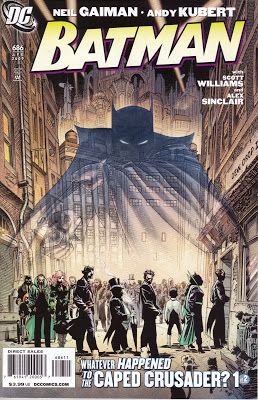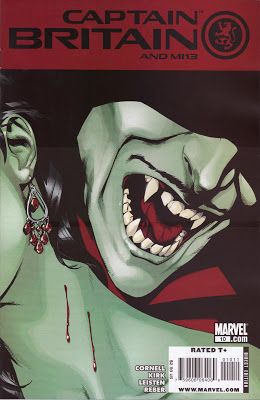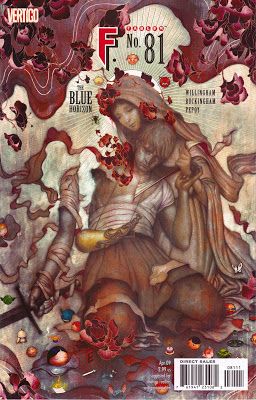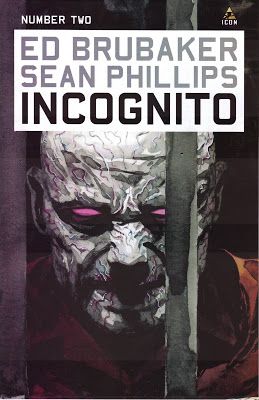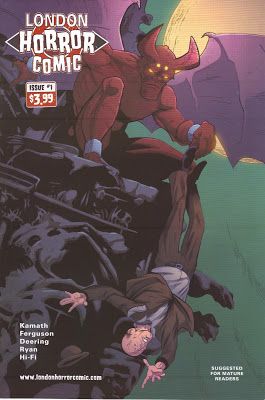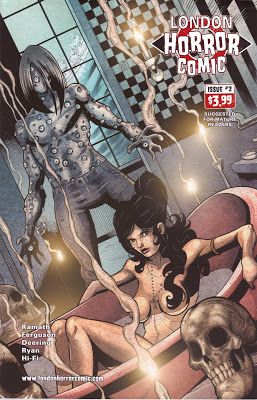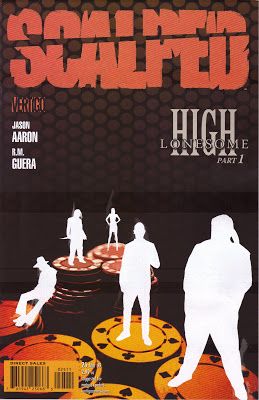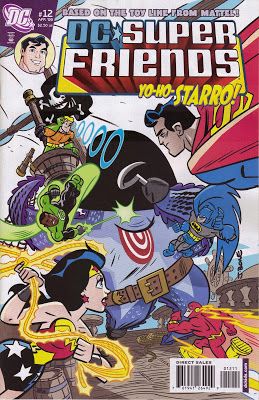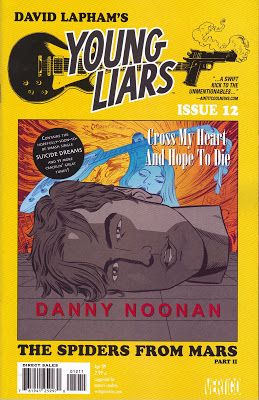Okay, so last week I returned from my month "off," and apparently you people forgot how we do things around here. I review comics, and then at least one of you tells me how a) stupid; b) Communist; or c) gay I am. Come on, people! Work with me, here. It's the Internet - this civility will not stand! I'll try to do my part by writing something objectionable, okay?
Batman #686 ("Whatever Happened to the Caped Crusader Part 1 of 2: The Beginning of the End") by Neil Gaiman (writer), Andy Kubert (penciller), Scott Williams (inker), Alex Sinclair (colorist), and Jared K. Fletcher (letterer). $3.99, 32 pgs, FC, DC.
Considering this is a Gaiman book, perhaps it's not surprising that it reads like an issue of Sandman. You may think that's a bad thing, but I certainly don't, as I really dig Sandman. It's the first of two parts, so it makes very little sense, but it's still an excellent issue, as several characters from Batman's past incongruously show up at the Dew Drop Inn (where a dude once dropped in) to attend Batman's wake. There's Selina Kyle, driving a cat car; Two-Face, driving a split-down-the-middle jalopy (we lost a great word when "jalopy" fell out of general use); there's the Joker driving a Joker car. Then Sadie Kelowski, a.k.a. Selina Kyle (a much older version than the one who pulls up in the beginning), stands up and starts telling how Batman ended up in the coffin in front of them. Then Alfred stands up and tells a different story about how Batman ended up in the coffin. Hmmm. Meanwhile, Bruce Wayne is apparently conversing with someone as he's watching the scene, and he's a bit puzzled. As are we all, Bruce. As are we all.
Of course, we expect it to make more sense after the second issue, but this one is quite good. I have no idea how much is taken directly from Batman's history and how much Gaiman makes up (I leave that to the OCD sufferers among us), but what he does nicely is come up with clever stories about the history of the Caped Crusader. Both stories feature surprises, a wry sense of humor ("I'm the goddamn Riddler!"), and a poking of the craziness of the Joker over the past few decades (during which he's become more of a sociopath, to the character's detriment), and Alfred's tale, particularly, is chilling in the way that it makes perfect sense, and is therefore all the more upsetting. (Also, when we consider Gaiman wrote the absolutely perfect Riddler story 20 years ago, his Riddler in this comic is more tragic than ever.) This is, like the best of Gaiman's stories about Morpheus, a comic about the power of stories, and I can't wait to see what Gaiman does with the second part. Oh, and Andy Kubert's art looks nice. He does a fine job switching styles between the modern day and the Golden Age feel Gaiman is going for in parts of the stories. The Joker's transformation, particularly (I don't want to give any more away than that), is brilliantly done.
If you've ever bought a Batman book, you'll probably like this. You don't even have to be aware of what Morrison has been doing with the character. Just this: Batman might be dead. All else follows from that.
Captain Britain and MI 13 #10 ("Vampire State: Prologue") by Paul Cornell (writer), Leonard Kirk (penciler), Jay Leisten (inker), Brian Reber (colorist), and Joe Caramagna (letterer). $2.99, 22 pgs, FC, Marvel.
A few days ago, Lorendiac was pointing out that Reginald Hudlin made Doctor Doom a racist to further his own agenda, and now, in the latest issue of Captain Britain, Cornell has made him speak anti-racism sentiments. Having just read Lorendiac's post, it was on my mind when, in the beginning of this comic book, Dracula, standing on the friggin' moon with Doom (it's so romantic!), says, while trying to convince Doom to help him carve out a vampire kingdom, "There is also the matter of Islam. It will close the gap with the West, in terms of science and super-powered individuals. Latveria stands on that border, as did my own land. The realm I would create would do without it, serve as a bulwark against it." Doom responds, "Spare me your racism, 'count.' I find it ridiculous in human leaders, because it is an assumption. But in an artifact, a mystical viral package such as yourself ... It's almost funny." I have several problems with this exchange (you just knew I would, wouldn't you?). First of all, Dracula wants to take over Britain, as we learn in the next panel. I can buy him ridding the British Isles of Muslims, but how would it be a bulwark against it? It's a freakin' island, last time I checked. It's right there in the name! Wouldn't he want to go back to his native lands, in Romania, and set up a line of defense there? If, in fact, he believes Islam will take over, say, Europe, how is sitting off the coast twiddling his thumbs going to be a "bulwark" against it? Dracula needs to consult an atlas, methinks. And then there's Doom's response. I'm not sure why people 2+ years ago (which is when I believe the exchange between Doom and Storm was written, in the wedding issue of Black Panther - although I could be wrong) were so bent out of shape with Doom being racist - he's a freakin' super-villain, for crying out loud, so claiming he's racist isn't all that out-of-character, is it? I mean, he's a megalomaniac, so he hates everyone, but why wouldn't he sprinkle in some racism, just to mix things up a bit? Anyway, hating Muslims isn't "racist." Islam, as Doom ought to know (he's so damned smart, after all), is a religion. You can't be racist for hating practitioners of a religion. I'm a white dude of Northern European stock, and I could be Muslim if I wanted to be. Dracula isn't talking about Arabs, after all, because the Muslims he dealt with weren't Arabs (Doom clearly calls him "Tepes," meaning in the Marvel Universe, he's linked to Vlad the Impaler, even if Bram Stoker never made that connection explicitly). Dracula was dealing with Turks, who are completely different ethnically from Arabs. And, given Dracula's "history," he has every reason to hate Muslims. So Doom is completely wrong calling him a "racist." And I don't even know why Cornell includes that scene with Doom - it's as if he really wants to go out of his way to show that Doom isn't racist. What does that even mean, that he finds it ridiculous in humans? He finds every person in the world ridiculous, because they can't match Doom's wonderful intellect! Man, it's silly. Oh, and I'm sure I missed something in the vast tapestry that is the Marvel Universe, but the last time I knew what Doom was up to, Norman Osborn was making him sit at a cramped table and ordering him around. Dracula says he has his kingdom back. When did that happen? I don't care too much, but it's something to know, I guess.
Man, look at all that. And that only takes us to page 2! The rest of the issue is rather good, however, as Cornell shows the team in some downtime situations, as Spitfire and Blade get a bit closer, Faiza wonders if being Dane's squire is really the best way to spend her time, and Brian moans about ditching his wife in Plotka's realm. I like how Liz says "I very much doubt you were a useless husband," when we saw, last issue, that he really was. Good move, Mr. Cornell!
And then, the book takes a turn for the absolutely awesome, as Dracula launches ... vampire assassin missiles at the Earth.
And I really can't say anything else, because Dracula just launched vampire assassin missiles at the freakin' Earth!!!!!!!
Fables #81 ("The Dark Ages Part 5: The Blue Horizon") by Bill Willingham (writer), Mark Buckingham (penciller), Andrew Pepoy (inker), Lee Loughridge (colorist), and Todd Klein (letterer). $2.99, 24 pgs, FC, DC/Vertigo.
The guy at my comic book shoppe read this before I got there, and he was still raving about it. Obviously, he wouldn't tell me what happened, but he couldn't stop talking about how stunning it was. So I read it. And it wasn't stunning.
Don't get me wrong - it's an excellent issue. From the beautiful cover (James Jean's last on the title, by the way) to the bad guy showing up in Fabletown (after the Fables have all left, of course) to Ambrose returning to the Farm stuffed with magic to heal Boy Blue to Blue's brutal conversation with Rose Red, it's a typically fantastic issue, but it's not all that stunning. It basically finishes part of the story left over from the war, and it ends pretty much the way we thought it would, if we know what Willingham's been doing for 80 issues. Maybe he just meant it was a really good issue. But every issue of Fables is really good. I'm puzzled.
Damn, that's a nice cover. I'm going to miss Jean.
Incognito #2 by Ed Brubaker (writer), Sean Phillips (artist), and Val Staples (colorist). $3.50, 25 pgs, FC, Marvel/Icon.
Brubaker and Phillips are once again making it hard for me to review one of their confounded comics, because Incognito, like Criminal, is one of those comics that doesn't appear all that groundbreaking, but it just works so well. Just the way the creators show two people communicating telepathically is perfect (and I assume Phillips letters the book, since none is credited). And of course there are people in the world like Amanda, as Brubaker gives us a brilliant explanation as to why she's not into Zack in his office-worker mode. And of course someone is going to figure out what Zack is doing, and of course there would be people who wouldn't necessarily run to the cops about it. This entire series so far has been moments that make you sit back and appreciate the craft that the two creators bring to it, even if it feels familiar, what with all the supervillains doing nasty things and such. And I didn't even get the Harvey Pekar reference in issue #1 (to be fair, it's kind of a weak reference), yet I still dig the comic!
As I mentioned last month, if something has to take the place of Criminal for a while, I'm perfectly happy that it's this. It's very nifty.
London Horror Comic #1 and 2 by John-Paul Kamath (writer), Lee Ferguson (artist), Marc Deering (inker), Matty Ryan (letterer), and Hi-Fi Design (colorist). $3.99 each, 33 pgs each, FC.
Okay, I'm probably going to get into some trouble with this book, but bear with me. It has absolutely nothing to do with the content of the actual comics.
John-Paul Kamath was kind enough to send this my way (he sent it Curran's way, too, so you can compare and contrast!), and I'd like to thank him. It's awfully groovy of him. The first issue came out in 2007, and the second one will be out in March. Should you plunk down your hard-earned coin on one or both?
Well, it's hard to say. The stories in the first one are better, but Ferguson's art in the second one is better. If you're a story person, you'll probably enjoy issue #1 more, but if you're an art person, you'll probably like issue #2 more. It's a pickle! Both are quite interesting, though, with Kamath going old-school on us to write short, 8-10-page stories, many with a Twilight Zone-ish twist at the end. For instance, in the very first story, a comic book writer is bemoaning the fact that the artist on a book gets all the chicks. Of course, a hot chick comes up to him and puts the moves on him, asking him to critique her unpublished manuscript. The writer thinks back to when he signed his exclusive contract with the publisher, when it was explained he couldn't critique unpublished manuscripts. He decides the chance for sex is too much to pass up, so he ends up in bed with the girl. Of course, we think the twist will be that his contract is something sinister, but Kamath pulls that rug out from under us, and the twist is something completely different, allowing Kamath to pick on writers once again. It's self-deprecating in a smug way, but endearing. The stories in issue #1 follow this template, as a vampire gets the tables turned on him in the second story (which is the funniest of the eight stories in the two issues), two policemen get involved in a creepy metafictional mystery in the third story, and a murderer transforms before our eyes in the fourth story, and it's somewhat upsetting. The second issue is a bit less horrific (to a degree), with two stories I just don't get. Both are wordless, and one features two suicide attempts that seemingly lead to romance, but in a weird way. I don't understand what's going on (and I don't want to write more about it, because I'm not about that). In the second one, a daughter appears to torture her blind mother (not in any graphic way, fret not), but I have no idea why she would want to. It's an effective story in showing how people are casually cruel to each other, but there's no reason for the young lady to be cruel. The other two stories are a superhero story with a twist (a fairly clever one) and a vampire story (more horrific than the first one) that shows why, if you're going to steal something, make sure it's the right thing. Ferguson, who is a fine artist, shows real growth from the first issue to the second one, with the suicide story, in particular, looking wonderful (even if I don't get it). The second vampire story looks great, too - it has a John K. Snyder III vibe to it. Ferguson is the artist (was the artist?) on The Many Adventure of Miranda Mercury, and it's good to see his stuff while that is in publication limbo.
But now, according to the writer of the comic, you may ignore everything I wrote above. Why? Well, this is what I have to rant about. At the back of the first issue, Kamath writes a text piece about publishing his comic. He writes about two filmmakers who had made their first movie, which had taken three years. One director said his marriage nearly collapsed, he almost lost his job and he nearly went bankrupt - all to make his movie. The response was less-than-stellar, and one audience member joked to Kamath that one would have thought someone would have told them their script was shit in the three years it took for them to make it. Kamath takes the person down a peg in a perfect passive-aggressive way, asking the person when his movie is coming out. Of course, the other person doesn't have a movie coming out, which amuses Kamath. His point, of course, is that "well done" always beats "well said," and if you want to do something, just get off your ass and do it, confound it! Well, he's right. But his subtler point is that if you haven't created something, you have no right to criticize someone who has created something. Yes, the audience member was crass, but he was simply expressing an opinion. Kamath has apparently had a hell of a time getting this book onto the market, and it's commendable that he not only got one, but two (at least) out, and they look great (especially the second one, which is printed in "prestige format," meaning the cover is heavier card stock and the colors look wonderful), but this attitude about criticism is awfully weird. You'll recall that I've run into this before, and it never rings true with me. If you are producing a work of art, you want people who don't create their own to review it. Kamath sent this to me, so he obviously wants me to review it, not because I am a great comics creator (although I'd KICK ASS on a Dazzler comic - make it happen, Joey Q!), but because he respects my views as a reviewer (I assume). And I can review this comic, I think, without being a creator. Again, the audience member made his opinion known in an obnoxious way, but it's just that. Just because someone doesn't produce a work of art doesn't mean that they can't or won't. Kamath mentions that one of the directors almost lost his marriage. I'm certainly not going to risk my marriage just to make a horror movie, because my marriage is too important to me. My kids are too important to me. Ultimately, there are more important things than art. That's not to say we should ignore Kamath's advice. I'm a stay-at-home dad (do you really think I'm employable?), so theoretically, I should turn off Pardon the Interruption occasionally and write something. But here's the thing: I am working on a comic (aren't we all?). It took me a year to find an artist, and yes, I put ads up on-line. Artists are flaky, I guess, because whenever I had one, he (or she) would flake out on me. Now I have one, but he has a full-time job, so he's slow too. And he's an artist in the "real world," so he's doing something he loves and doesn't need to do my stupid book (although I appreciate the fact that he's doing it). But again - I'm in no hurry. It'll get done. I'm not going to sacrifice my marriage and family for it, though.
Okay, so I'm a bit off-topic. I'm sure that Kamath is just ranting against people who dismiss others' creative output without doing something themselves, which I would never do. I assume I'm allowed to bash this comic, although I don't want to. It's fun to read and makes you happy that people out there are actually getting stuff out for our entertainment. Go visit Kamath's web site and order the book for yourself (well, go to the site and find out how to order the book). For 4 dollars, it's certainly as good as a lot of what Marvel's trying to sell you for the same price!
And I'll have to keep an eye out for issue #3. I hope it doesn't take two years!
Scalped #25 ("High Lonesome Part 1 of 5: Then This is the Rez") by Jason Aaron (writer), R. M. Guéra (artist), Giulia Brusco (colorist), and Steve Wands (letterer). $2.99, 24 pgs, FC, DC/Vertigo.
One thing Aaron does nicely in Scalped is show how truth is shaped by people's perceptions. Black-and-white morality people might not want to hear it, but it's true, and Aaron has always done a fine job with this comic showing how, viewed one way, an event might look evil, but viewed another way, it might look decent. This is most evident, of course, with the murder of the FBI agents in 1975, mirroring the actual event on the Pine Ridge reservation for which Leonard Peltier still sits in jail (whether you believe he's guilty or not). Aaron has put Lincoln Red Crow, a vile man by all accounts, at the site in 1975, and throughout the series, we've been given glimpses of the man Red Crow could be but refuses to be. With his new story arc, Aaron writes an entire issue about perception, as he introduces a new character, a black con artist who shows up at Prairie Rose and tries to beat the casino. From the very beginning, when Aaron gives us a brief look at Little Big Horn and Wounded Knee and writes that even if everyone wants them to go away, the Indians are still here, he's subverting the truth. His narration sounds noble, but then the con artist asks a Native why they don't move to where the jobs are. The Indian tells him that they fight back by living even though no one wants them to. We're impressed with that sentiment, until the con artist ruminates that it's an idiotic attitude, because he himself was in that kind of situation and he got out and made his own life. That, we think, is the way to live. But then, as his schemes unfold and he hooks up with a stripper from the casino, we start to realize how pathetic he is. And then he shows self-awareness about how pathetic he is, and we start to wonder if he can be redeemed. But even his disgust with what he is can't overcome the life he's chosen, and Aaron brings the story back to the main narrative of the book - one does exist, after all - and sets up a fiery confrontation in the subsequent issues. It's a remarkable piece of work, considering it's only 24 pages long.
I haven't been reviewing this book too long, as I bought the first 18 issues in trade, but I should point out that Guéra is amazing, and nudity has a lot to do with that. Yes, NUDITY! The stripper in this issue appears in 26 panels (yes, I counted), and she's never clothed. Not once, except for the thong she wears on stage for four panels. It's a measure of Guéra's talent that she goes through the entire book naked, but we concentrate more on her interaction with the con artist and the way she looks at him throughout the comic. She's also typical of the naked women in this book, in that she's attractive and has a nice body, but it's still a realistic body. Her boobs droop a bit, because that's what boobs do, and she has real curves. It's always nice to see a comic where people look like people and act like people, which means walking around naked occasionally! Of course, because this is America, we never see the con man's penis. Let's not go crazy - we still have some limits in this country!
Anyway, it's a very good single issue, but it's also a very good way to start a story arc. Even if you haven't been following the series, it's an issue you could pick up and understand. So why don't you? Maybe it will inspire you to buy the rest of the series!
Super Friends #12 ("Starro and the Pirates") by Sholly Fisch (writer), Stewart McKenny (penciller), Dan Davis (inker), Travis Lanham (letterer), and Heroic Age (colorists). $2.50, 20 pgs, FC, DC.
Well, I very much doubt if any cover this year will be better than that one. The Super Friends fighting a giant Starro pirate? Fucking gold! Oh, is that inappropriate when discussing a kids' comic? Whoops.
This issue isn't as good as the last issue, partly because it's not quite as insane, and Chynna Clugston didn't draw it. McKenny is fine, but weirdly enough, his heroes look a bit too 'roided-out, which is odd. But it's Starro! With pirates! It's a nice little tale, as Starro comes up with a dastardly plan to take over the world by turning a group of scientists into pirates. What's his plan? Oh, wouldn't you like to know, you scalawags! But I'm certainly not telling! This leads to Starro siccing his little mind-control dealies on the Super Friends, and you know who saves the day? FUCKING AQUAMAN, BITCHES! So stop dogpiling on Aquaman, you dicks! It hurts his feelings!
Despite being a bit too politically correct (oh, like the Batmobile doesn't pollute the shit out of Gotham City), it's a fun adventure. And even though it "doesn't count," as Brad Curran might rant, it's almost worth it for the cover alone. And John Stewart yells, "For justice!" with no irony whatsoever. You gotta love that!
Young Liars #12 ("The Spiders From Mars, Part 2") by David Lapham (writer/artist), Lee Loughridge (colorist), and Jared K. Fletcher (letterer). $2.99, 22 pgs, FC, DC/Vertigo.
Oh, Young Liars. You're like that weird chick who lets you do stuff in the bedroom that no one else ever let you do, and you know you should settle down with a respectable girl from Iowa, become a Methodist, get a corporate job, and have three kids (a boy, a girl, and then a boy to break the tie), but you just can't let that weird chick go. You just know that if Young Liars was that weird chick, she'd be into felching. YOU KNOW IT!!!!!!
This is a comic that features a decapitation on the first page (based on the cover, you get no guesses as to who the victim is) and the reader isn't even that nonplussed, as a decapitation after last issue's mind-blowing ending is par for the freakin' course. And then Danny is suddenly in a world where everything seems normal, and he doesn't know what to do about it. But then Lapham explains (?) what's going on, and it makes sense? Okay, it makes sense only because I've read many, many comic books, where shit like this does happen, so Lapham isn't quite as unique as we'd like to think, but come on - the flair with which he's throwing this at us is astonishing. As always with this book, I totally understand if you don't like it - I can't say that for all the comics I buy (why the hell doesn't motherfucking Rex Mundi sell 200,000 copies?!?!?!?!?) - but at the same time, I always think if you dropped it before, the latest issue (whichever issue it happens to be) will be the one to bring you back. But, of course, that's impossible, because what Lapham is doing in this latest issue is what he's been doing the entire year, and if you didn't like it in issue #2, you probably won't like it in issue #12. And as usual, what I love about it is that you simply cannot predict what's going to happen from page to page, much less issue to issue. You can't say that about many comics. And there's a full-page spread of Sadie slaughtering a bunch of people. SOLID GOLD!!!!!!
How's that? Who wants to besmirch my ancestry? You can do it! And let's look at some totally random lyrics!
"I go down to Speaker's Corner, I'm thunderstruck
They got free speech, tourists, police in trucks
Two men say they're Jesus, one of them must be wrong
There's a protest singer singing a protest song"
I think I'm the only person in the world who likes that song. I don't care!!!!!


